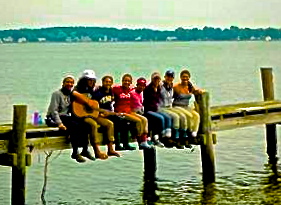On this journey I’ve observed that there are different responses whenever people are confronting an environmental issue(s). Sometimes it’s making national parks or refugees, others are learning about the hardship with living alongside such a pressing problem, and even attending a conference where policies and methods are being discussed. All these different reactions helped me to be exposed to what people do as a community to address and fix environmental crisis that are occurring locally and globally. What is great about having these real-life moments was to discover that I had the opportunity to be apart of it all because of the program I’m in. The Chesapeake Semester and programs like it can really inspire young students to become more aware of the efforts being made to finding solution for our environment in the most interesting ways possible.
The first kind of response which I had mentioned when facing any type of environmental problem was establishing national and federal parks by the government. By doing this, it means that acres of land are preserved so that species of plants and animals can thrive in their ecological habitats. The last place that my group and I had visited on our journey was Chincoteague which has the National Wildlife Refuge. Unfortunately, we couldn’t see the preserve because the government had shut down at the time. So to make up for it we visited the barrier island of Assateague and Ocean City to learn more about the geography and future of such a tourist place. Still this preserve has a huge range of habitats that are maintained and regulated; including maritime forests, dunes, salt marshes, and freshwater. This place is well protected from any kind of destruction and prevents displacement of organisms, it is even home to the famous Chincoteague ponies. We did get to play at the beach and while there, we caught sight of the elusive ponies which was neat to see. I think it’s really important to have national parks and refugees so that people can be educated about the importance of saving the environment and it’s inhabitants.
During the journey, we traveled to Smith Island where the community there is still trying to live despite the pressing environmental issues of erosion and sea level rising. While sediments are being washed away by strong storms and boat waves, climate change has caused the water to rise and expand further inland. This island will eventually disappear completely underwater however one would never think there is a dying community as a result because of these problems. Somehow everyone there has continued to live their daily lives by adapting to the changes of the island. In fact, nothing much has changed since the first time people came to Smith Island for the crabs, oysters, and fishes. There are no more oysters and the crab population has declined but the crab-picking and packaging business is still being run, now by three families. Since the town is small; most hospital emergences, high school education, and grocery shopping is done on the main island. Even though their home isn’t going to be there in the near future, the people really want to keep the Smith Island culture alive by staying. Coming to this island helped me understand a different way of responding to an environmental crisis and that is by just trying to continue living and adapting.
One of the more unique experiences on this journey was at the beginning when I got the opportunity to attend the Alliance for the Chesapeake Watershed Forum. In this conference, 200 conservation programs were brought together and the representatives discussed the environmental crisis that the Chesapeake Bay is currently facing. Listening to what they’ve had to say and the efforts towards making a more sustainable approach to save the Bay, gave me a new point of view of how environmental problems are being addressed. One of the ideas that I really loved was using an ecological, political, and ethical approach when talking about any environmental issues. All three have significance and should be considered in the context when trying to find a solution. The speakers were trying in part to promote that being sustainable was a “cool thing” to do and that it’s very important we start now. This idea was again supported when I got to meet recently graduated student during the poster session at the end of the conference. I got to learn about their individual projects and where in their career they would like to head towards. This whole conference allowed me to discover a different way of reactions when facing environmental crisis and that was finding new ideas and policies that can reach a possible solution or more. I hope that in the future as I also help conquer the number of environmental problems we’re facing, that I can take a number of different approaches and find the most suitable answers.


